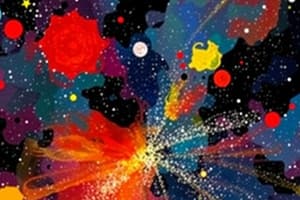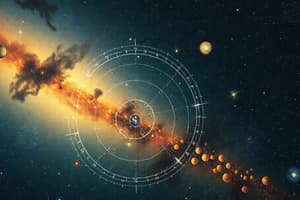Podcast
Questions and Answers
How is the Sun classified?
How is the Sun classified?
- As a neutron star
- As a giant star (correct)
- As a medium star
- As a white dwarf
Which object is created during the formation of a star?
Which object is created during the formation of a star?
- A nebula
- A supernova
- A supergiant
- A protostar (correct)
What causes a star to shine brightly?
What causes a star to shine brightly?
- The energy that is released (correct)
- The amount of gravity that is present
- The types of elements that are present
- The color that is produced
What is the main element that stars are made of?
What is the main element that stars are made of?
What is the initial stage of all stars?
What is the initial stage of all stars?
What happens first when a star begins to run out of fuel?
What happens first when a star begins to run out of fuel?
Some objects in space are created from clouds of gas and dust. What will happen if the cloud does not have enough mass?
Some objects in space are created from clouds of gas and dust. What will happen if the cloud does not have enough mass?
Which factor causes gas and dust to pull together during the first stage of star formation?
Which factor causes gas and dust to pull together during the first stage of star formation?
Which object forms when a supergiant runs out of fuel?
Which object forms when a supergiant runs out of fuel?
Which event takes place first in the stages before the birth of a star?
Which event takes place first in the stages before the birth of a star?
Flashcards are hidden until you start studying
Study Notes
Star Classification and Formation
- The Sun is classified as a medium star, distinguishing it from giant stars, white dwarfs, and neutron stars.
- A protostar is created during the initial formation of a star from a nebula.
Star Characteristics and Composition
- Stars shine brightly due to the energy that is released from nuclear fusion, rather than the color they produce or their gravity.
- The primary element that makes up stars is hydrogen, which serves as the main fuel for nuclear fusion.
Stages of Star Development
- The initial stage of all stars begins in a nebula, a massive cloud of gas and dust in space.
- When a star starts to deplete its fuel, the first change observed is the shrinking of the star's core.
Mass and Star Formation
- If a cloud of gas and dust does not possess sufficient mass, a star will not form.
- During the first stage of star formation, gravity serves as the key factor that compacts gas and dust together.
Outcomes of Stellar Evolution
- When a supergiant star exhausts its fuel, it can collapse into a neutron star.
- The sequence leading to star birth begins with gravity pulling gas and dust together, followed by the formation of a protostar.
Sequential Events in Star Lifecycle
- The critical first step in the lifecycle of a star is the gravitational accumulation of gas and dust, prior to protostar formation and nuclear fusion.
Studying That Suits You
Use AI to generate personalized quizzes and flashcards to suit your learning preferences.




